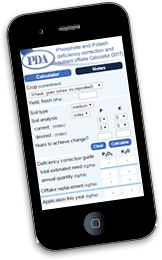PDA News
The PDA publishes both technical News items and shorter Blog items. PDA News provides the latest up to date information on macronutrients and their use, while blog items are shorter and timelier.
If you are in the UK or Ireland and are interested in receiving PDA News items through the post or by email free of charge, then sign up on the contact page. Recipients can receive CPD points for BASIS and NRoSO.
Standard recommendations cannot make a poor soil good overnight
A crop receiving the rate of potash (or phosphate) recommended in the Fertiliser Manual (RB209) for a soil at Index 0 or 1 is still very unlikely to perform as well as it could on an Index 2 soil. The standard recommendation at phosphorus (P) or potassium (K) Index 0 or 1 is in two […]
July 2012
Good soil potash reserves are required for efficient nitrogen use
In the spring there is understandably much talk of nitrogen applications, growth regulators and how well crops have come through the winter. It is seldom accompanied by discussion of the importance of potash on the efficiency of nitrogen utilisation, on the ability of cereal crops to resist going down, or on the resistance of the […]
March 2012
Balanced nutrition shown by nitrogen:sulphur ratios
In a recent Newsletter the pattern of uptake of potassium and some other nutrients during the growing season was shown. The same French data-set also analysed the crops for the patterns of nitrogen (N) and sulphur (S) uptakes. The majority of the N and S in crops (other than the Brassicae, such as oilseed rape, […]
November 2011
Potassium uptake requirements of some crops
Fertiliser recommendations for potash (K2O) are usually based on removal or offtake of K2O at harvest. Some detailed results of measurements on K2O uptake during crop growth show that greater care is needed to ensure potash supply meets crop requirement. Difference between uptake and offtake The amount of a nutrient needed for full growth of […]
July 2011
Disappointing first cut yields due to drought are no reason to neglect potash and sulphur
Yields of first cut grass have been lower than average in many parts of the UK. Pockets of the south west and N Ireland aside, yields down by as much as 30% have been reported from Wales, Scotland and the midlands, north west and north east of England. Some grassland farmers may have delayed cutting […]
June 2011
Updated cereals recommendations and correction of K deficiency
The new revised PDA leaflet ‘Potash for Cereals‘ incorporates the changes to the recommendations for cereals in the updated Fertiliser Manual (RB209). For potash these relate to the reduction in the quantity of baled straw which is assumed to be removed per tonne of harvested grain (see PDA leaflet ‘Nutrients in Crop Material‘), now half […]
January 2011
Can your crops get enough Kredit from their soil bank?
Growing plants require far larger quantities of potash than is usually recommended as a fertiliser dressing. This may sound surprising but the fertiliser recommendation is calculated from the amount of potash removed from the field when the crop is harvested, not from the amount needed by the crop when it is growing at its full […]
August 2010
Missed applications of potash put arable crops at risk
Recent booklets and press articles in Britain have given advice on management guidelines for winter wheat and on how to avoid flat crops, but often with little mention of the fundamental need for balanced nutrition. Most of the discussion centres around nitrogen (N), which one publication describes as “the most important nutrient”. As Liebig taught […]
March 2010
Soil sampling and different methods of arable cultivation
This article has been updated – follow this link to read the latest version www.pda.org.uk/soil-sampling-different-methods-of-arable-cultivation/ Soil sampling for the routine measurement of P, K, Mg Indices and pH is familiar to most advisers and farmers. The same well-proven method has been used for many years – 25 cores taken in a ‘W’ or grid pattern […]
December 2009
Some frequently asked questions about P and K
Q: How much potash do I need to apply to raise my soil K Index to the target Index of 2-? A: This depends on soil type. Heavy soils will require more potash than light soils. When less potash is applied than is removed the K Index on light soils will fall more quickly than […]
August 2009
Nutrient management risks for major crops
About 70% of the income from arable cropping in the UK (excluding fruit and vegetables) comes from cereals and oilseeds. Given the primary importance of these crops it is surprising that such risks are taken with their performance. Figure 1 shows the area of winter wheat and of oilseed rape which received a dressing of […]
July 2009
Cereal straw – nutrient contents
Straw has always been an important by-product of cereal production, with its main use historically being as feed and bedding for livestock. This remains the primary use, but other markets have developed over recent years, particularly as a result of the low profitability of arable farming and the need to maximise returns through the sale […]
June 2009

